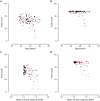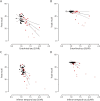Associative memory and in vivo brain pathology in asymptomatic presenilin-1 E280A carriers
- PMID: 32611637
- PMCID: PMC7538214
- DOI: 10.1212/WNL.0000000000010177
Associative memory and in vivo brain pathology in asymptomatic presenilin-1 E280A carriers
Abstract
Objective: To determine whether performance on the Free and Cued Selective Reminding Test (FCSRT) is associated with PET in vivo markers of brain pathology and whether it can distinguish those who will develop dementia later in life due to autosomal-dominant Alzheimer disease (AD) from age-matched controls.
Methods: Twenty-four cognitively unimpaired Presenilin-1 E280A carriers (mean age 36 years) and 28 noncarriers (mean age 37 years) underwent Pittsburg compound B-PET (amyloid), flortaucipir-PET (tau), and cognitive testing, including the FCSRT (immediate and delayed free and cued recall scores). Linear regressions were used to examine the relationships among FCSRT scores, age, mean cortical amyloid, and regional tau burden.
Results: Free and total recall scores did not differ between cognitively unimpaired mutation carriers and noncarriers. Greater age predicted lower free recall and delayed free and total recall scores in carriers. In cognitively impaired carriers, delayed free recall predicted greater amyloid burden and entorhinal tau, while worse immediate free recall scores predicted greater tau in the inferior temporal and entorhinal cortices. In turn, in all carriers, lower free and total recall scores predicted greater amyloid and regional tau pathology.
Conclusions: FCSRT scores were associated with in vivo markers of AD-related pathology in cognitively unimpaired individuals genetically determined to develop dementia. Difficulties on free recall, particularly delayed recall, were evident earlier in the disease trajectory, while difficulties on cued recall were seen only as carriers neared the onset of dementia, consistent with the pathologic progression of the disease. Findings suggest that the FCSRT can be a useful measure to track disease progression in AD.
© 2020 American Academy of Neurology.
Figures




References
Publication types
MeSH terms
Substances
Grants and funding
LinkOut - more resources
Full Text Sources
Medical
